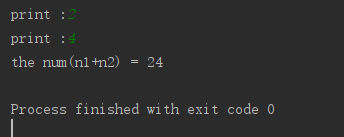目录
向上取整math.ceil()和向下取整math.floor()
1.random.choice(序列),在序列中随机选取一个数
2.random.choice(range(10)),从0~9的范围内随机生成一个数
4.random.randrange(),在1-99的数值中取出1+2*n的数值,因为1+2*n,所以结果都为奇数
5.随机生成[0,1]之间的小数,random.random()
定义变量和常量
变量:可以改变的量
常量:程序运行期间不能改变的量
在输入是如果没有定义输入量的类型,将会变成字符串来运算
n1 = input("print :")
n2 = input("print :")
print("the num(n1+n2) =",n1+n2)
在输入时定义输入量为整型,输出结果为两输入量相加
n1 = int(input("print :"))
n2 = int(input("print :"))
print("the num(n1+n2) =",n1+n2)
数字:
整数:python可以处理任意大小的整数,当然包括负整数
- 可以连续定义变量 num1 = num2 = num3 =10
- 交互式赋值定义变量 num1,num2 = 5,10
浮点数:由整数部分和小数部分组成,浮点数运算可能会有四舍五入的误差
复数:实数部分和虚数部分组成
打印变量类型
使用type(变量名)来打印变量类型
n = 10
print("the num =", type(n))
n = "10"
print("the num =", type(n))
查看变量地址
使用id(变量名)查看变量存储的地址
print(id(n))![]()
删除变量
del 变量名
删除后变量无法引用
n1 = int(input("print :"))
n2 = int(input("print :"))
del n2
print("the num(n1+n2) =",n1+n2)
数字类型转换
浮点数转整型,没有四舍五入
print(int(1.1))
整数转浮点数
print(float(1))
字符串转整型
print(int("123"))
字符串转浮点数
print(float("12.3"))
转换时+/-号在前代表正负
print(int("+123"))
print(int("-123"))
数学函数
导入库import math
绝对值abs()
print(abs(-10))
print(abs(-10.5))
比较两个数的大小
在下列公式中,如果n>m则返回1,否则返回-1,如果相等则返回0
n=10
m=6
print((n>m)-(n<m))
print((m>n)-(m<n))
实质是Boolean类型之间的比较,true-false为1,false-true为-1
print(True-False)
print(False-True)
获取给定序列的最大值max()和最小值min()
print(max(1,3,5,7,4,6,2))
print(min(1,3,5,7,4,6,2))
求X的Y次方pow()
pow(x,y)
print(pow(3,4))![]()
四舍五入round()
如果不在后面输入数字确定要保留几位小数,结果将精确到整数
print(round(2.343))
print(round(2.786))
print(round(2.786,2))
向上取整math.ceil()和向下取整math.floor()
import math
print(math.ceil(4.4))
print(math.floor(4.4))
返回小数部分和整数部分math.modf()
import math
print(math.modf(4.4))![]()
开平方math.sqrt()
import math
print(math.sqrt(4))![]()
随机数
1.random.choice(序列),在序列中随机选取一个数
print(random.choice([1,2,3,4,5,6]))2.random.choice(range(10)),从0~9的范围内随机生成一个数
print(random.choice(range(10)))3.随机从字符串中取出一个字符
print(random.choice("asbdsgj"))号码匹配测试
import random
n = random.choice(range(100))+1 #随机找1~100以内的一个数
m = int(input("请输一个数值:"))
if m == n:
print("号码匹配")
else :
print("号码不匹配")
4.random.randrange(),在1-99的数值中取出1+2*n的数值,因为1+2*n,所以结果都为奇数
print(random.randrange(1,100,2))5.随机生成[0,1]之间的小数,random.random()
print(random.random())![]()
可以使用round()来确定生成随机小数的位数
print(round(random.random(),2))![]()
6.将链表序列随机排序
list = [1,2,3,4,5]
print(list)
random.shuffle(list)
print(list)
7.随机产生一个实数,范围在3-9以内
print(random.uniform(3,9))表达式
由变量、常量和运算符组成的式子
算术运算符: + 加 - 减 *乘 / 除 **求幂(x^y) //取整
if语句
格式:
if 表达式 :
语句
else :
语句
如果表达式的值为0 0.0 '' None False,则为假,不执行下面的语句
没有学循环语句写水仙花数
153 = 1^3 + 5^3 + 3^3
import math
n = m = int(input("请输入数值: "))
a = n%10
n //= 10
b = n%10
n //= 10
c = n%10
if m == math.pow(a,3)+math.pow(b,3)+math.pow(c,3) :
print("是水仙花数")
else:
print("不是水仙花数")
一起学习,一起进步 -.- ,如有错误,可以发评论